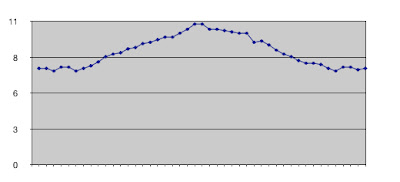I was talking with someone a few days ago about the unemployment rate, and pointing out that in his first term, President Obama has a better record on unemployment than both Presidents Reagan (
see it here) and George W Bush (
see it here) in
their first terms. This person claimed that the unemployment rate looks artificially better than it really is because of a drop in the Labor Participation Rate.
Defining terms
The
unemployment rate is the percentage of the
work force that's out of work, but looking for work.
The
Labor Participation Rate (LPR) is the percentage of the general population of the country that's in the
work force. You aren't in the work force if (1) you're under 16, (2) you're institutionalized (in a nursing home, in prison, or in the military), (3) you aren't available for work (retired, a stay-at-home parent, disabled, etc.), or (4) you haven't looked for work in more than a year.
The LPR is falling! The LPR is falling!
Back to the story. The person I was talking to claimed that the LPR is dropping because so many workers have grown discouraged and have left the workforce. He pointed out that the LPR has dropped from 65.8% when Obama took office to 63.6% now. And, he said, lowering the size of the work force makes unemployment look lower than it really is.
So let's look at those two claims: (1) the reason people are leaving the workforce is that they're growing discouraged, and (2) a smaller work force makes the employment situation look better than it is.
Why is the LPR dropping?
Data on the LPR is available from the
Bureau of Labor Statistics (BLS). The data does indeed show that the LPR is dropping. However, it shows that the LPR has been dropping since 2000.
Here, let's look at a chart of the LPR from 1960 to the present:
 |
| Labor Participation Rate 1960 - present (chart courtesy BLS) |
|
|
Does that shape look familiar? It should, it's the first part of the classic bell-shaped curve. It shows that the LPR began to increase about 1965, reached its peak in the late 1990's, and began to decline in 2001.
Are there anything that can account for that bulge? Of course, and it should be obvious - the Baby Boomers. Boomers were born between 1946 and 1964. The bell-shaped curve begins it upward sweep when the first Boomers joined the job market in the mid 60's, and it began declining when the first boomers began retiring around the turn of the century. Now,
about 10,000 Boomers are retiring every day. From the link:
A recent article by the Chicago Federal Reserve Bank estimated that at
least half of the decline in the labor force participation rate (LFPR)
in the recent recession was due to retirement.
I'm not saying that
none of the LPR drop is caused by the recession, but the bell-shaped curve caused by the Boomers leaving the job market is clearly a major factor.
So I think I've established that the drop in the LPR isn't caused by the recession (although the recession does have some impact).
Now, let's turn to the second claim. Namely, that those who retired in discouragement aren't counted as part of the work force and are therefore making the unemployment situation looks better than it really is.
I'm discouraged. Do I count?
Remember the definition of terms up above? If not, scroll back up and take a look at who's defined as not in the work force. It's OK - I'll wait.
Welcome back - let's continue. The 4th reason for someone not being in the work force is that they haven't looked for a job in more than a year. As long as they
want to work, are
available for work, and have
looked for a job at any point any time in the last year, they're counted as part of the work force. These folks are called "discouraged workers" by the BLS.
As I've said before, the BLS reports on several unemployment statistics every month. Among them is the report on
U-6 unemployment. U-6 includes those discouraged workers. And it, like the more frequently reported U-3 ("official") unemployment report, has been dropping. In the last year, it's dropped a full percentage report, from 15.7% to 14.7%.
So the
only people who would cause the LPR to go down
and who wouldn't appear as unemployed are those who meet all these conditions:
- Over 16
- Not in a nursing home, prison, or the military
- Unemployed
- Want to work
- Are available for work
- Haven't applied for any job in more than a year
I know a few unemployed people, but I don't know anyone who meets all those criteria. I suspect they're pretty rare. If anyone out there can find any hard data one way or another on this subject, I'd love to see it.














